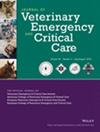An exploratory study on the effect of rescuer team size on basic and advanced life support technical skills in a high-fidelity simulation of canine cardiopulmonary arrest
Abstract
Objective
To evaluate the effect of rescuer team size on objective skill measures of basic life support (BLS) and advanced life support (ALS) using high-fidelity canine CPR simulation.
Design
Prospective, experimental study.
Setting
Veterinary clinical simulation center.
Subjects
Forty-eight Reassessment Campaign on Veterinary Resuscitation CPR-certified veterinary students.
Measurements and Main Results
Five groups of participants each conducted 3 CPR simulations in configurations of 4, 6, and 8 rescuers. Simulations represented a shock patient declining into asystole, followed by ventricular fibrillation and return of spontaneous circulation. Resuscitation efforts were video-recorded to evaluate BLS and ALS tasks. Mean (±SD) was derived and data were compared among team sizes using ANOVA and Tukey's post hoc analysis. Significance was set at P < 0.05. Among teams of 4, 6, and 8 rescuers, time to first chest compression (13 s [±6], 9 s [±2], 8 s [±4]; P = 0.24) and positive-pressure breath (101 s [±37], 56 s [±15], 67 s [±24]; P = 0.05) were not significantly different. Chest compression (100/min [±5], 108/min [±6], 107/min [±6]; P = 0.12) and ventilatory rates (9/min [±1], respectively, P = 0.52) were not significantly different. Time without chest compressions/total length of CPR was not significantly different (72 s [±16], 61 s [±16], 54 s [±8]; P = 0.15). Capnography and ECG monitoring were used by all teams. Time to first vasopressor administration was significantly different among team sizes (268 s [±70], 164 s [±65], 174 s [±34]; P = 0.04), with vasopressors being most quickly administered by teams of 6 rescuers. Time to electrical defibrillation was not significantly different (486 s [±45], 424 s [±22], 488 s [±181]; P = 0.57). Incorrect ALS interventions occurred in 60%, 0%, and 40% of CPR events in 4, 6, and 8 rescuer teams, respectively.
Conclusions
Although the achievement of BLS tasks was comparable in teams of 4 rescuers, teams of 6 rescuers may be preferable based on differences in the rate of guideline-incompliant treatments and ALS task efficiency. Teams of 8 rescuers were neither more efficient nor more accurate at conducting BLS and ALS tasks.


 求助内容:
求助内容: 应助结果提醒方式:
应助结果提醒方式:


